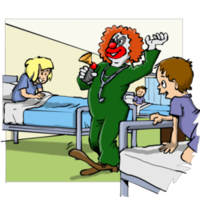Spirituality, Depression and Suicide

It is an interesting sign of the times that a major medical publication – the Southern Medical Journal – has dedicated an entire section this month to a series of papers on the Spirituality/Medicine Interface Project that is being supported by the John Templeton Foundation.
Attention to our spirituality is an important part of fulfilling our potential and treating people in trouble. It is no accident that Integrated Medicine always includes all of the five major dimensions of an individual:
- Physical
- Psychological
- Social
- Subtle
- Spiritual
To get a bit technical, each of the five domains or dimensions contains something of each of the others. The body, mind and spirit and not separate but part of one whole. Mind, consciousness and spirit permeate the body.
We sometimes use the technical term “Five Interlinked Nested Domains” or “FINDS,” to reflect this reality.
An important principle of this interconnected health model is that it’s almost always a mistake to look for a single cause for a problem, imbalance or illness. Not only is it usually incorrect to think about “one illness, one cause,” but it is also usually not enough to use just one therapy or one health maintenance plan: Carefully coordinated combinations are key, for they generate a powerful synergy.
Because the domains are interlinked, physical and psychological health, to say nothing of our social health, and the health of our subtle systems are difficult to maintain without spiritual health. The road to spiritual health begins with understanding and following the natural laws of the Universe, finding your true Purpose and applying both to the service of others.
The articles in this issue of the Southern Medical Journal are excellent.
Here are some highlights:
Dan Blazer from Duke University provides an introduction that gives a fine overview of the growing field of spirituality in medicine in general and depression in particular
Harold Koenig, also from Duke has an article entitled, “Spirituality and Depression: A Look at the Evidence”
Bob Cloninger from Washington University in St. Louis writes about “Spirituality and the Science of Feeling Good.”
Unfortunately the abstracts and papers are not yet available on line, except to members of the Southern Medical Association. Hopefully the Templeton Foundation will be able to arrange with the Journal to make at least the abstracts freely available.
If they do, I shall let you know.
Otherwise, if you have ready access to a library, and if you are interested in this important and rapidly growing field, I am sure that they will be able to help you.
Solar Cycles and Human Disease

We have all heard about the supposed association between full moon and mental illness, though most of the research has failed to find an association between phases of the moon and mood disorders or psychosis.
But something that we have not heard so much about is the possible association between solar activity and human problems.
Investigators from Chile presented some interesting data (NR308) at the 2007 Annual Meeting of the American Psychiatric Association in San Diego last month.
They used a measure of solar activity called the Wolf number that is based on the number of sunspots. The sunspot cycles are usually between 9.5 and 11 years. They examined the clinical records of 1862 individuals who had been seen at a psychiatric clinic in Santiago over a sixteen-year period, which corresponded to one and a half solar cycles. They found that there was a big rise in admission for severe depression during years with low solar activity and a slight increase in the number of admission for mania during years of high solar activity.
This is not the first time that a connection has been found between the sun and human affairs.
The same authors published a paper in Spanish two years ago in which they also found that depression is more common when there is less solar activity and mania increases when there is more activity. They cannot say whether it is just light that is causing this or some other form of radiation.
Two researchers used the Maine Medicaid database to look at the relationship between solar cycles and human disease, and found that that radiation peaks in solar cycles and particularly in chaotic solar cycles (CSCs) are associated with a higher incidence of mental disorders. The same researchers had previously used the same database to suggest that CSCs produce more ultraviolet radiation and it is this that limits human longevity by causing chromosomal damage.
Interestingly, in 1993 two researchers also suggested a relationship between solar activity and longevity. They looked at the mean longevity of birth cohorts from 1740 to 1900 for United States of America (U.S.) Congressional Representatives exhibited oscillations that coincided with the 9- to 12-year sunspot cycle. They found that the mean longevities of these cohorts were 2-3 years longer during times of low sunspot activity than at peak activity. This phenomenon was confirmed in data from members of the House of Commons of the United Kingdom Parliament and from University of Cambridge alumni.
Researchers in Slovakia have suggested that there may be an association between solar radiation and cerebral strokes, though their data is a little difficult to interpret.
It is clear that the Heavens have more of an impact upon us than many scientists realized, and need to be factored into studies of human mood and behavior.
Larks, Owls and Depression

It is well known that mood disorders are associated with the disruption of many of the circadian rhythms of the body including sleep, temperature and thyroid function. These links are so well known that many experts believe that depression may be a consequence of disturbances in circadian rhythms.
Although circadian rhythms tend to be fairly consistent across individuals, but there are significant differences in these rhythms in different people: we call this the “morningness-eveningness” dimension (MED).
As part of a larger project, researchers from Providence, Rhode Island last month presented a most interesting study (NR293) at the 2007 Annual Meeting of the American Psychiatric Association in San Diego.
People with psychiatric problems tend to be owls: evening types who don’t like mornings, and this was particularly striking in people with depression.
This suggests that “eveningness” may be reflecting a risk factor or vulnerability to psychopathology, in particular depression. It may actually be that if you are a “morning person,” you may have some protection against developing depression.
I remember seeing a study from Stanford in April that suggested that people labeled a “night owls” report more pathological symptoms related to insomnia, despite many having the opportunity to compensate for their nocturnal sleeplessness by extending their time in bed and being able to gain more total sleep time. So this may be the link with depression.
Yoga and the Brain

Depression and anxiety are increasingly common throughout the world, and although each may be a consequence of psychological and environmental stresses, there is also a genetic predisposition and an increasing number of reproducible disturbances in the brain.
In recent years, there has been increasing interest in the role of brain gamma-aminobutyric acid (GABA) levels, which is the brain’s primary inhibitory neurotransmitter, in both depression and anxiety, following the finding that each may be associated with low levels of GABA in different regions of the brain.
There have also been reports that yoga may help stress and anxiety as well as depression.
Now colleagues from Boston University School of Medicine (BUSM) and McLean Hospital have found that practicing hatha yoga may elevate brain GABA levels.
This new research is published in last month’s issue of Journal of Alternative and Complementary Medicine.
The researchers used magnetic resonance spectroscopic imaging to compare the GABA levels of eight subjects before and after one hour of yoga. The control group consisted of 11 people who read a book or magazine instead of doing yoga. They found a twenty-seven percent increase in GABA levels in the yoga practitioner group after their session, but no change in the comparison subject group after an hour spent reading.
It is too early to start recommending yoga for the treatment of depression or anxiety, but it is fascinating that it will produce changes in brain chemistry that are very similar to those that we hope to achieve with other forms of therapy.
Humor and the Treatment of Depression

There is a well-known story about the writer Norman Cousins who claimed to have beaten ankylosing spondylitis by watching Laurel and Hardy and Marx Brothers movies. In his book Anatomy of an Illness as Perceived by the Patient, he chronicles the way in which he laughed his way to health.
In recent years there has been a great deal of interest in the idea of using laughter to prevent and treat mood disorders. We have Laughter Clubs and even Laughter Yoga.
When you first hear about it, the whole idea sounds preposterous: if you are suffering from clinical depression, it is not very likely that you are going to feel like laughing.
So it was very interesting to see some new research (NR46) from colleagues at Cedars-Sinai Medical Center that were presented yesterday at the 2007 Annual Meeting of the American Psychiatric Association in San Diego, California.
Some literature has suggested that humor may help reduce stress and anxiety, but the data has been inconclusive.
The researchers investigated the dispositions toward humor of a group of depressed patients in the outpatient psychiatric department at Cedars-Sinai. Patients were asked to complete a short questionnaire comprised of a regular depression scale as well as Svebak’s Sense-of-Humor Questionnaire.
The researchers had predicted that the level of depression and inherent sense of humor of an individual would determine whether or not they thought that humor would be a viable component of treatment.
In fact there was no correlation with either: depressed people were remarkably receptive to the idea of including humor in their treatment. The researchers are now planning some controlled studies of incorporating humor into the treatment of depressed patients.
Perhaps Patch Adams was right all along!
Non-pharmacological and Lifestyle Approaches to Attention-Deficit/Hyperactivity Disorder: 3. Herbal Remedies

Herbal medicines are crude drugs of vegetable or plant origin, which are used for the prevention or the treatment of disease states or to attain or maintain a condition of improved health. The use of herbs can be divided into four main categories:
- Folk Herbalism: You may well have come into contact with this: we use the term folk herbalism to describe traditional healing methods based upon plants. Many of our ancestors brought folk remedies from Europe or learned of healing herbs from Native Americans
- Western Medical Herbalism: This has been developing in Europe over the last century, and represents an attempt to classify and codify medically useful herbs
- Ayurvedic Herbalism: This is the ancient traditional herbalism of the Indian Subcontinent. Some Ayurvedic herbs have found their way into conventional medicine. The best-known example is the drug reserpine, which was at one time used for treating high blood pressure and mania. It was extracted from the Himalayan bush Rauwolfia serpentina. Ayurvedic herbs are most readily available in cities with large Indian populations
- Chinese Herbalism: One of the five branches of traditional Chinese medicine, there are many thousands of Chinese herbs, which are usually administered in complex combinations. Though most are prepared with close attention to detail, there have been many reports in the literature of adulteration of Chinese herbs with heavy metals.
Herbs are used directly as teas or extracts, or they may be used in the production of drugs. Around 25% of the prescription drugs sold in the United States are plant based. Two good examples are aspirin, which was originally extracted from the bark of the willow tree and digoxin, a purified form of digitalis, from the foxglove. Many more herbal ingredients are present in over-the-counter medicines, particularly in laxatives.
Herbal medicines are considered to be dietary supplements; therefore they are not required to meet the standard for drugs specified in Federal Food, Drug, and Cosmetic Acts. They are only required to meet the standards set forth in the 1994 Dietary Supplement and Health Education Act (DSHEA). Furthermore, they may be produced without complying with standards for good manufacturing practice. They also do not need the prior approval of safety and efficacy by the Food and Drug Administration (FDA). So long as the term “disease” is not on the label, the FDA has no regulatory powers.
Many herbal products have been used to treat Attention-Deficit/Hyperactivity Disorder (ADHD), and there are hundreds of websites claiming that their products are effective. However the research is often not quite what it seems. Some sites simply use loads of testimonials, but happily there are others who have products supported by empirical research. The use of herbal remedies in ADHD is popular in Europe, although the problem is less widely recognized in that part of the world. The most popular include sedative herbs, herbs used to enhance brain function, antioxidants and stimulants. The last category is herbs that are used to treat other symptoms, particularly mood disorders that are very common in adults with ADHD.
Medical reviews of herbal remedies do not always make the point that herbalists typically individualize the treatment for the individual. So two people with apparently similar symptoms may receive different treatments.
They are often used together with a whole-foods diet, high in protein and complex carbohydrates and low in simple sugars.
Sedative herbs
Sedative or calming herbs are amongst the most popular herbal options for treating ADHD. These include:
Chamomile
Hops
Lemon balm
Valerian
Kava kava
Sedative herbs may be helpful in promoting sleep in children who have trouble falling asleep. They are generally safe, but there is little scientific evidence that they can improve daytime behavior in children with ADHD, and it is important to be aware that they are medicines that do have side effects and may interact with each other and with prescription medicines. Here is a chart of some interactions between medicinal herbs and drugs.
Brain “enhancing” herbs
A small open study of 36 children with ADHD who were treated with a combination herbal combination of Panax quinquefolium (200 mg) + Ginkgo biloba (50 mg) twice daily for 4 weeks, reported an improvement in 74% at the end of the study. The combination was marketed as AD-FX, but it has recently become difficult to obtain it in the United States for commercial rather than legal reason. Gingko has become one of the most popular herbs given to children with ADHD, but more research is necessary: there is enormous variability in the quality of commercially available herbs. Gingko may also cause bleeding in people at risk of it. It was interesting that Panax was included: there are reorts of people becoming more hyperactive in overdose.
Antioxidant herbs
Pycnogenol (pine bark extract) has been tested in a randomized, controlled trial involving 61 children who received either 1 mg/kg/day Pycnogenol or placebo for 4 weeks. In this study, Pycnogenol was associated with a significant reduction of hyperactivity, improved attention, eye-hand coordination, and concentration. When the herb was stopped, the symptoms returned within a month. An earlier short study in adults had failed to find an effect, but it could have been because of the dose used.
Stimulant herbs
Coffee, tea, and cocoa all have stimulant effects that tend to be milder than medications. Caffeine helped spatial learning deficits in an animal model of ADHD, and there have been several small studies of caffeine, but most have failed to find much benefit. In a double-blind cross-over trial of just 8 boys with ADHD modest doses of caffeine (160 mg, roughly equivalent to 1.5 cups of coffee) were less effective than large doses of methylphenidate (20 mg) in improving behavior. Although many adults self-medicate with coffee, few use it in children with ADHD. And it can, of course, cause insomnia and anxiety.
Chinese herbalists use multiple combinations and there have been some publications (1, 2, 3,) suggesting that further work on Chinese herbal medicines might be worthwhile. The methods of some Chinese medical research studies are rather different from those done in the West, so we need to be a little cautious.
There are some herbs and supplements that are linked to an increase in symptoms of hyperactivity including:
Yohimbine
Korean ginseng
Siberian ginseng
American ginseng
L-glutamine
Conclusions
Although there is some data, and a lot of practical experience, it is still not clear who is likely to benefit from which herbal remedy. The variable quality of herbal products and the risk that some may be contaminated has added to the uncertainty. It is also important to remember that herbs are drugs, and that they can interact with each other and with prescription medicines, and that just because they are natural, does not necessarily mean that they are safe.
After all, deadly nightshade, arsenic and hurricanes are natural as well.
An Important Change in the Warning on Antidepressant Medicines
If we could, we would only use natural medicines to treat depression.
Sadly it is not always possible to do that, and it doesn’t help when people with a demonstrable biochemical disturbance are told that their depression is all about internalized anger or an unwillingness to face some issue in their lives.
The trouble with those theories is that they often don’t take into account a tragic fact: depression can be fatal.
Not only because of the risk of suicide and other kinds of self-injury, but because depression is associated with many physical problems including chronic inflammation and carbohydrate intolerance.
Today the United States Food and Drug Administration (FDA) asked makers of all antidepressant drugs to change the existing "black box" labels on their products to warn about increased risk of suicidality (suicidal thinking and behavior) among young adults aged 18 to 24 in the first few weeks of treatment.
The FDA has also asked the pharmaceutical companies to revise the existing warning to show that there is no evidence that this risk exists for adults over 24, and furthermore, for those aged 65 and older the scientific data suggests the suicidality risk is decreased.
The American Psychiatric Association (APA) said this:
"The FDA’s new labeling acknowledges, for the first time, that untreated depression puts people at risk for suicide."
They said that studies showed that the old label issued in 2004 was associated with a steep drop in use of antidepressants and was followed by an increase in the rate of suicide "reversing a decade-long decline in suicide deaths in the United States".
The FDA said the emphasis on the new labels should be that depression and other serious psychiatric illnesses are themselves the most important causes of suicide.
Director of FDA’s Center for Drug Evaluation and Research, Dr Steven Galson said that:
"Today’s actions represent FDA’s commitment to a high level of post-marketing evaluation of drug products."
"Depression and other psychiatric disorders can have significant consequences if not appropriately treated. Antidepressant medications benefit many patients, but it is important that doctors and patients are aware of the risks."
The FDA recommends that people who are currently taking antidepressants should not stop taking them as a result of hearing this news.
The warning revision applies to all antidepressants and comes in the wake of controlled trials that showed a reasonably consistent risk of suicidality across most of the antidepressant drug categories. The FDA said that the evidence does not support excluding any antidepressant medication from this update request.
This update request follows the labeling changes made in 2005 to warn of increased suicidality in children and adolescents taking antidepressants.
Since then, the FDA undertook a comprehensive review of 295 drug trials examining the risk of suicidality among adults taking antidepressants.
The trials included over 77,000 adult patients with major depressive disorder (MDD) and other psychiatric conditions.
The results was that in December last year, the FDA’s Psychopharmacologic Drugs Advisory Committee said labels should be changed to tell doctors about the increased risk of suicidality among younger adults taking antidepressants.
The Committee also said the labels should remind doctors that the disorders themselves present the greater risk, and that among older adults the antidepressants do not carry the suicidality risk and have an apparent beneficial effect.
The FDA is preparing drafts of patient guides and wording for the labels. The manufacturers have 30 days to submit their own versions for FDA review.
The drugs affected include:
— Anafranil (clomipramine)
— Asendin (amoxapine)
— Aventyl (nortriptyline)
— Celexa (citalopram hydrobromide)
— Cymbalta (duloxetine)
— Desyrel (trazodone hydrochloride)
— Elavil (amitriptyline)
— Effexor (venlafaxine hydrochloride)
— Emsam (selegiline)
— Etrafon (perphenazine/amitriptyline)
— Lexapro (escitalopram hydrobromide)
— Limbitrol (chlordiazepoxide/amitriptyline)
— Ludiomil (maprotiline)
— Luvox (fluvoxamine maleate)
— Marplan (isocarboxazid)
— Nardil (phenelzine sulfate)
— Norpramin (desipramine hydrochloride)
— Pamelor (nortriptyline)
— Parnate (tranylcypromine sulfate)
— Paxil (paroxetine hydrochloride)
— Pexeva (paroxetine mesylate)
— Prozac (fluoxetine hydrochloride)
— Remeron (mirtazapine)
— Sarafem (fluoxetine hydrochloride)
— Seroquel (quetiapine)
— Sinequan (doxepin)
— Surmontil (trimipramine)
— Symbyax (olanzapine/fluoxetine)
— Tofranil (imipramine)
— Tofranil-PM (imipramine pamoate)
— Triavil (perphenazine/amitriptyline)
— Vivactil (protriptyline)
— Wellbutrin (bupropion hydrochloride)
— Zoloft (sertraline hydrochloride)
— Zyban (bupropion hydrochloride)
The APA said:
&
quot;We believe the new label, which still contains important warning information, reminds physicians and patients that antidepressants save lives. Physicians and patients need all the facts in order to make appropriate, informed decisions about any proposed course of treatment."
This change is not in any way an indictment of the medicines, it just acknowledges the reality that depression is dangerous.
Why is the risk apparently greater in younger people? It is thought that it has to do with the fact that the frontal lobes of the brain, that are involved in the control of emotions, have not yet fully formed.
Linking Depression, Diabetes and Alzheimer’s Disease

It has been known for many years that Alzheimer’s disease and depression are associated with type 2 diabetes. Good control of blood glucose may reduce the risk of developing Alzheimer’s disease and depression, while treating depression may improve metabolic control.
Decreased levels of brain-derived neurotrophic factor (BDNF) have also been implicated in the pathogenesis of Alzheimer’s disease and depression, and animal models have suggested that BDNF may play a role in insulin resistance.
So a group of scientists at The Centre of Inflammation and Metabolism, Department of Infectious Diseases at the University of Copenhagen in Denmark, decided to see whether BDNF plays a role in human glucose metabolism.
In the first study they looked at 233 people and found that BDNF was inversely associated with fasting plasma glucose, but not with insulin. In a second smaller study they did what are known as hyperglycemic and a hyperinsulinemic-euglycemic clamp studies, that allowed them to look at the relationships between BDNF, glucose and insulin. What they found was that output of BDNF from the brain was inhibited when blood glucose levels were elevated.
So it seems that low levels of BDNF accompany impaired glucose metabolism. Decreased BDNF may be a factor involved not only in dementia and depression, but also in type 2 diabetes, and it may be the missing link that explains the way in which the three conditions cluster together in epidemiological studies
This link between a chemical produced in the brain and diabetes is not altogether unexpected. The French physiologist Claude Bernard demonstrated that stimulation of the fourth ventricle of the brain caused glucose to rise, and it was later found that opiates put into this region of the brain could do the same thing.
This study reinforced the close links between metabolism and the brain, and gives us another reason for recommending that as we get older we must ensure that out glucose remains stable and that we do not become depressed.
Fats, Inflammation and Depression

We have talked before about the associations between inflammation and psychiatric illnesses.
There is yet more evidence in the shape of a study just published in the journal Psychosomatic Medicine. by Janice K. Kiecolt-Glaser and her colleagues from Ohio State University College of Medicine in Columbus.
The study involved 43 older adults with a mean age of 66.67 years, and the results suggests that the imbalance of omega-6 and omega-3 fatty acids in the typical American diet could be associated with the sharp increase in heart disease and depression seen over the past century. The more omega-6 fatty acids people had in their blood compared with omega-3 fatty acid levels, the higher their levels of the inflammatory mediators tumor necrosis factor-alpha and interleukin-6, and the greater the chance that they would suffer from depression. These are the same inflammatory mediators associated with insulin resistance, type 2 diabetes and coronary artery disease, all of which are more common in depression. And depression is more common in diabetes, arthritis and coronary artery disease than expected.
Our hunter-gatherer ancestors consumed two or three times as much omega-6 as omega-3, but today the average Western diet contains 15- to 17-times more omega-6 than omega-3. There were 6 individuals in the study who had been diagnosed with major depression, and they had nearly 18 times as much omega-6 as omega-3 in their blood, compared with about 13 times as much for subjects who didn’t meet the criteria for major depression.
Depressed patients also had higher levels of tumor necrosis factor alpha, interleukin-6, and other inflammatory compounds. And as levels of depressive symptoms rose, so did the omega 6 and omega 3 ratio. So it seems as if the effects of diet and depression enhance each other. People who had few depressive symptoms and/or were on a well-balanced diet had low levels of inflammation in their blood. But when they became more depressed and their diets became worse – which is very common when people are depressed – then the inflammatory mediators in the blood surged.
Omega-3 fatty acids are found in foods such as fish, flax seed oil and walnuts, while omega-6 fatty acids are found in refined vegetable oils used to make everything from margarine to baked goods and snack foods. The amount of omega-6 fatty acids in the Western diet increased sharply once refined vegetable oils became part of the average diet in the early 20th century.
Depression alone is known to increase inflammation, the researchers note in their report, while a number of studies have found omega-3 supplements prevent depression.
So this more evidence for the value of eating fatty fish like salmon, mackerel or sardines two or three times a week, but be sure to avoid fish that may contain a lot of mercury. If you add more fruits and vegetables to your diet, you will also reduce your levels of omega-6 fatty acids.
I have just finished analyzing all the new literature on using fish oils for the prevention and treatment of psychological and psychiatric problems, and I am going to post my findings in the next couple of days.
Risky Advice About Bipolar Disorder
Sad to say, I see a lot of articles on medical topics that don’t make much sense. Most are well-meaning so I usually just let them go unless the suggestions are dangerous or unwise. I have just seen an unfortunate example of both.
The writer is talking about natural treatments for depression and bipolar disorder. He or she first divides depression into three groups: mild, major and severe.
I have not seen that done in many years and it betrays a real misunderstanding of the illness. People with genuine depression or bipolar disorder can get very ill very quickly, and these are illnesses in which as many as a quarter to a half of all sufferers attempt suicide. So it is risky to minimize the severity of the illness.
The writer then talks about “Bipolar Depression is a severe condition of depression that has manic undertones.”
This is simply not accurate. The “manic phase” of bipolar II disorder may be very mild, or present as intermittent anxiety or irritability. There is a great deal of discussion going on about the clinical features of all the different forms of bipolar disorder as we begin work on DSM-V. He or she appears here to be talking about “Mixed states,” about which, as it happens, I shall be lecturing tomorrow.
The author deserves kudos for saying that medications may be necessary, but the potentially dangerous thing was the advice to use St. John’s Wort in “Mild” cases of bipolar disorder. St. John’s Wort may have a role in the treatment of mild to moderate depression: the experts are still deliberating about that. But the problem of using it in bipolar disorder is that it may precipitate mania. One of several reasons for the changing clinical features of bipolar disorder in recent years is the over-prescription of antidepressants and self-medication. It is always difficult to prove causality, but here are a few papers on the dangers of using St. John’s Wort in people who may have bipolar disorder: 1, 2, 3, 4, 5, 6.
Integrated Medicine constantly uses conventional medicine together with natural approaches, and respects the psychological, subtle and spiritual aspects of any life challenge. But have to be very careful about how we combine different approaches so that we don’t do more harm than good.
Be careful of advice that you read online!






